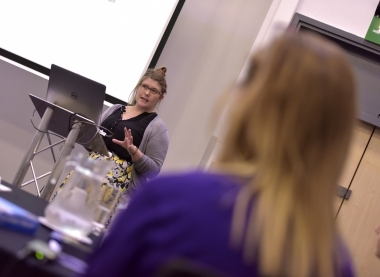Education
Latest
How Well are Young People Prepared for Work - Skills Show 2016
Last month, Birmingham's NEC once again played host to the UK Skills Show. As well as showcasing the competitors and exhibitors, the show also provided useful opportunities for discussion on the big issues in skills.

One session looked at the role of Local Enterprise Partnerships (LEPs) in preparing young people for work. This discussion provided the opportunity for Gatsby's careers programme manager, Beth Jones, to explain the progress to date with our pilot with the North East LEP in embedding our eight benchmarks of good career guidance in schools and colleges.
Transcript below of Beth Jones' contribution:
The Gatsby Foundation believes good career guidance is important for everyone; for students who might choose to follow academic or technical pathways and those choosing to study STEM subjects and beyond.
Career guidance provides young people with experiences and understanding of the work place and helps them make more informed decisions about their future. This is particularly important for young people in challenging circumstances who may not have support networks or access to this information outside of school or college.
I’m not sure anyone can point to a golden age of career guidance in the UK and the focus is often on what is going wrong in schools. So in 2014, Gatsby challenged Sir John Holman, working with researchers at Derby University, to establish what good career guidance actually looks like.
By reviewing the evidence, speaking to teachers, students and government officials in these six countries eight benchmarks (SLIDE) were identified that defined what good career guidance should look like in schools.
Many of you will have seen these before. In summary:
- A stable plan – that allows students, parents and teachers to know what they need to do, when they need to do it, and who can help them to achieve it
- Information – about the labour market, possible careers, the pathways to get there and the impact of their decisions
- Encounters - with employers through regular interactions, prolonged work experiences and access to staff and pupils at a variety of colleges and university
- Personal guidance – to help young people navigate the maze of information and choices available to them
I’d like to emphasise at this point that I have just summarised these benchmarks. The report not only describes underpinning research but also additional detail about each benchmark. For example, the report specifies that, from age 11, every young person should have an encounter with an employer every year.
With a clear definition of what good looks like internationally with these eight benchmarks, it’s possible to look at the health of school career guidance in the UK and assess the scale of the challenge for preparing young people for work. In 2014 we surveyed over 350 schools and it’s safe to say that there is still a long way to go: only 69% of schools fully met even one benchmark.
However, that statistic paints a rather bleaker picture than was actually seen in schools during the survey. There is good activity happening out there, and good progress towards the benchmarks in many schools, it is just that that activity is variable across the sector.
And this is one of the biggest challenges. Variation.
Yes. The needs of young people vary, so the approach to reaching each benchmark will vary, but there should not be variation in the quality of career guidance young people receive.
We want to ensure as many schools as possible are supported to achieve the benchmarks and the challenge isn’t insurmountable.
We have therefore been funding a pilot in the North East of England [SLIDE], led by the Local Enterprise Partnership, monitoring and evaluating 13 schools and three colleges that are using different approaches to reaching the benchmarks from different starting points and with different challenges.
It started last September and runs until summer 2017 and after one year we have seen significant progress in all schools to achieving the benchmarks.
At the start of the pilot no school achieved more than three benchmarks, and eight achieved none. Three schools now achieve 5, equivalent to the best schools in the 2014 survey, but what is more impressive is 15 of the schools are achieving elements of every benchmark. They had access to a small amount of funding, but this has not been the driver of change (many have not claimed their funding). It is the clear that it is the framework of the benchmarks, with support from the LEP, that has focused efforts within the pilot institutions.
I’m not going to focus on the specific initiatives each school and college has used because they are varied and many. For example, secondary schools and colleges in South Tyneside have pooled their resources through a fair funding model to pay for central support. Several schools have developed peer-to-peer messaging through student career ambassadors. There have been business breakfast, careers fairs, 12 week employer cadet programmes, teachers spending time with employers…. The list goes on. But I want to focus on how it could be possible to replicate what has worked in the North East across the country; and I’ll just make two key points here.
- Firstly, there is no single magic bullet. Preparing every young person for the workplace is complicated and we shouldn’t shy away from that by focussing on one benchmark or one stakeholder in the system or one project or one approach. The benchmarks DO provide an accessible framework that schools colleges and others can use to structure improvement ensuring everyone is working towards a share aim. To help people begin this process we have worked with the CEC to develop Compass a free audit tool which allows schools to see how they are doing against the benchmarks. This evaluation process was a valuable process for all the schools and colleges, whatever their starting point. We hope others will find this tool a useful way to identify their strengths, focus resources and track their process.
- Secondly, I want to talk about leadership. Regional leadership and school and college career leadership.
a. High quality coordination at a regional level is important for the schools in the pilot. Within the pilot the LEP facilitator, motivates and coordinates schools and colleges, brokers relationships with employers and other organisations such as the Careers and Enterprise Company Advisor scheme, signposts provision and help institutions interpret the labour market information, using LEP intelligence.
b. Schools and colleges need a careers leader conducting the orchestra of careers activity that takes place across the school. In the Netherlands this person is called The School Deekan and this model has emerged in many institutions in the pilot. This Careers Leader has credibility with senior leadership and governors and oversee the delivery of the benchmarks (e.g experiences of the workplace, curriculum development, 1:1 guidance interviews). High quality career leadership ensures that careers guidance is at the heart of the school and college. They can identify, celebrate and share their strengths and to target resources to areas of most need. A system where every institution has a Careers would create a much needed coherent structure that would enable to variety of great organisations to plug into and support schools and colleges.
Gatsby continues to support good career guidance, and we are looking at the emerging lessons from the pilot and considering how we can support Careers Leaders in the future.
Fundamentally schools care about their students and they want them to have a positive and fulfilling future. That is ultimately why teachers teach. The work being carried out in the North East is testament to this. So our job, collectively, is to create a stable system that allows them to do this and we suggest that the eight benchmarks can create a structure for this to happen.
Visit the career benchmarks programme page for more information.

